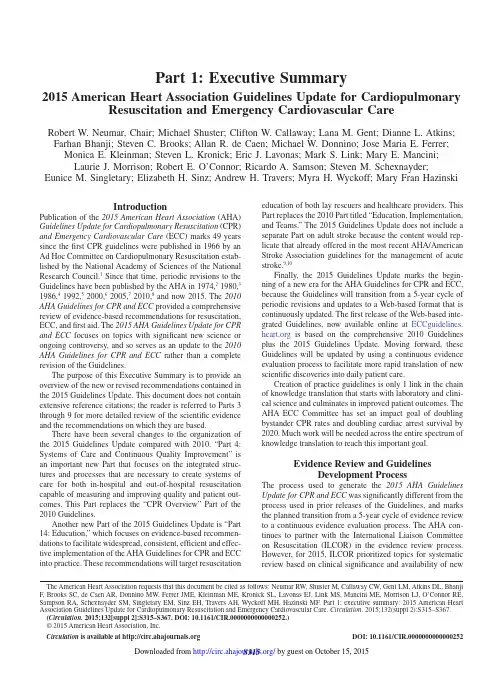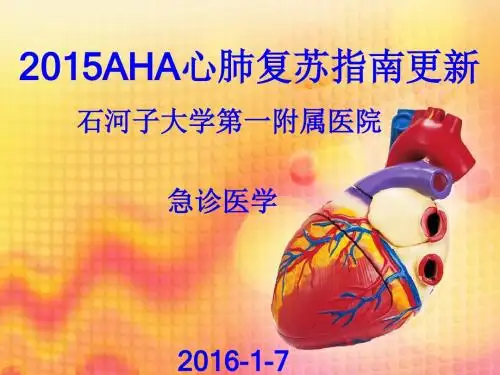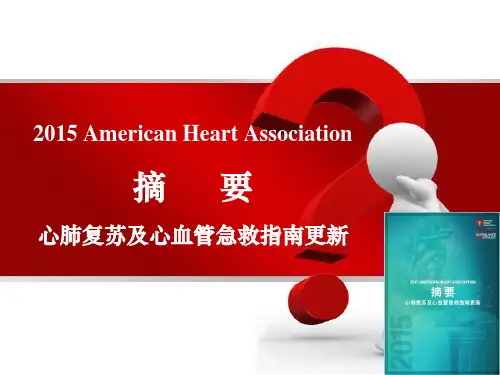2015美国AHA心肺复苏指南更新总结资料
- 格式:ppt
- 大小:2.10 MB
- 文档页数:17

美国A H A心肺复苏指南 Company number【1089WT-1898YT-1W8CB-9UUT-92108】2015最新美国心脏协会A H A心肺复苏指南美国心脏学会(AHA)10月15日在网站上公布了2015版心肺复苏及心脏急救指南。
下面分为两部分,着重强调新旧版的区别及变更理由,并附重要图表方便大家记忆。
第一部分:2015AHA心肺复苏指南更新要点第一部分非专业施救者心肺复苏1、关键问题和重大变更的总结2015《指南更新》建议中,有关非专业施救者实施成人心肺复苏的关键问题和重大变更包括下列内容:1.院外成人生存链的关键环节和2010年相同,继续强调简化后的通用成人基础生命支持(BLS)流程。
2.成人基础生命支持流程有所改变,反映了施救者可以在不离开患者身边的情况下启动紧急反应(即通过手机)的现实情况。
3.建议在有心脏骤停风险人群的社区执行公共场所除颤(PAD)方案。
4.鼓励迅速识别无反应情况,启动紧急反应系统,及鼓励非专业施救者在发现患者没有反应且没有呼吸或呼吸不正常(如喘息)时开始心肺复苏的建议得到强化。
5.进一步强调了调度人员需快速识别可能的心脏骤停,并立即向呼叫者提供心肺复苏指导(即调度员指导下的心肺复苏)。
6.确定了单一施救者的施救顺序的建议:单一施救者应先开始胸外按压再进行人工呼吸(C-A-B而非A-B-C),以减少首次按压的时间延迟。
单一施救者开始心肺复苏时应进行30次胸外按压后做2次人工呼吸。
7.继续强调了高质量心肺复苏的特点:以足够的速率和幅度进行按压,保证每次按压后胸廓完全回弹,尽可能减少按压中断并避免过度通气。
8.建议的胸外按压速率是100至120次/分钟(此前为“至少”100次/分钟)。
9.建议的成人胸外按压幅度是至少厘米,但不超过6厘米。
10.如果有疑似危及生命的、与阿片类药物相关的紧急情况,可以考虑由旁观者给予纳洛酮。
这些变更是为了对简化非专业施救者的培训,并强调对突发心脏骤停患者进行早期胸外按压的重要性。

7A版优质实用文档2015 AMERICAN HEART ASSOCIATION摘要心肺复苏及心血管急救指南更新目录简介 (1)伦理学问题 (2)急救系统和持续质量改进 (3)成人基础生命支持和心肺复苏质量:非专业施救者心肺复苏 ..5 成人基础生命支持和心肺复苏质量:医护人员BLS (7)心肺复苏的替代技术和辅助装置 (11)成人高级心血管生命支持 (13)心脏骤停后救治 (14)急性冠脉综合征 (16)特殊复苏环境 (18)儿科基础生命支持和心肺复苏质量 (20)儿童高级生命支持 (23)新生儿复苏 (25)培训 (27)急救 (29)参考文献 (32)致谢The American Heart Association thanks the following people for their contributions to the development of this publication: Mary Fran Hazinski, RN, MSN; Michael Shuster, MD; Michael W. Donnino, MD; Andrew H. Travers, MD, MSc; Ricardo A. Samson, MD; Steven M. ScheGnayder, MD; Elizabeth H. Sinz, MD; Jeff A. Woodin, NREMT-P; DianneL. Atkins, MD; Farhan Bhanji, MD; Steven C. Brooks, MHSc, MD; Clifton W. Callaway, MD, PhD; Allan R. de Caen, MD; Monica E. Kleinman, MD; Steven L. Kronick, MD, MS; Eric J. Lavonas, MD; Mark S. Link, MD; Mary E. Mancini, RN, PhD; Laurie J. Morrison, MD, MSc; Robert W. Neumar, MD, PhD; Robert E. O’Connor, MD, MPH; Eunice M. Singletary,MD; Myra H. Wyckoff, MD; 和AHA《指南摘要》项目组。

2015年AHA心肺复苏及心血管疾病指南更新要点2015年AHA心肺复苏及心血管疾病指南更新要点10月15日,美国心脏协会(AHA)发布了2015版《心肺复苏及心血管急救指南更新》(以下简称《指南更新》),2015《指南更新》是基于国际证据评估流程,由来自39个国家的250位证据审查专家共同参与完成。
指南更新要点如下:新AHA 建议级别和证据水平分级体系2015《指南更新》中使用的建议级别和证据水平,均依据AHA的最新定义。
最新版定义中的3级建议有所更改,3级:无益,当证据显示,有高质量或中等质量研究(证据水平LOE分别为A或B)表明某项策略的效果并不优于对照组时,不常使用。
证据水平也有所更改。
LOE B 现分为LOE B-R(随机研究)和LOE B-NR(非随机研究)。
LOE C 现分为LOE C-LD(有限数据)和C-EO(专家意见)。
总的来说,复苏学的证据水平和建议级别都较低,2015 版的所有建议中仅1%(315条建议中有3条)基于最高证据水平(LOE A),仅25%的建议(315条建议中78条)被认定为1级(强建议)。
2015《指南更新》中的大部分建议(69%)都只有最低证据水平的支持(LOE C-LD 或C-EO),将近一半(315条建议中有144条,45%)被定为2级(弱建议)。
急救系统和持续质量改进2015《指南更新》为利益相关方提供了一个审视救治体系的新视角,区分了院内心脏骤停(IHCA)和院外心脏骤停(OHCA)。
要点包括•救治体系通用分类•将AHA成人生存链分为两链:一链为院内救治体系,另一链为院外救治体系•检视有关心脏骤停救治体系的最佳证据的评估,集中在心脏骤停、ST段抬高型心肌梗死(STEMI)和卒中问题上。
非专业施救者心肺复苏2015《指南更新》建议中,有关非专业施救者实施成人心肺复苏的关键问题和重大变更包括下列内容:•院外成人生存链的关键环节和2010年相同,继续强调简化后的通用成人基础生命支持(BLS)流程。


IntroductionPublication of the 2015 American Heart Association (AHA) Guidelines Update for Cardiopulmonary Resuscitation (CPR) and Emergency Cardiovascular Care (ECC) marks 49 years since the first CPR guidelines were published in 1966 by an Ad Hoc Committee on Cardiopulmonary Resuscitation estab-lished by the National Academy of Sciences of the National Research Council.1 Since that time, periodic revisions to the Guidelines have been published by the AHA in 1974,2 1980,3 1986,4 1992,5 2000,6 2005,7 2010,8 and now 2015. The 2010 AHA Guidelines for CPR and ECC provided a comprehensive review of evidence-based recommendations for resuscitation, ECC, and first aid. The 2015 AHA Guidelines Update for CPR and ECC focuses on topics with significant new science or ongoing controversy, and so serves as an update to the 2010 AHA Guidelines for CPR and ECC rather than a complete revision of the Guidelines.The purpose of this Executive Summary is to provide an overview of the new or revised recommendations contained in the 2015 Guidelines Update. This document does not contain extensive reference citations; the reader is referred to Parts 3 through 9 for more detailed review of the scientific evidence and the recommendations on which they are based.There have been several changes to the organization of the 2015 Guidelines Update compared with 2010. “Part 4: Systems of Care and Continuous Quality I mprovement” is an important new Part that focuses on the integrated struc-tures and processes that are necessary to create systems of care for both in-hospital and out-of-hospital resuscitation capable of measuring and improving quality and patient out-comes. This Part replaces the “CPR Overview” Part of the 2010 Guidelines.Another new Part of the 2015 Guidelines Update is “Part 14: Education,” which focuses on evidence-based recommen-dations to facilitate widespread, consistent, efficient and effec-tive implementation of the AHA Guidelines for CPR and ECC into practice. These recommendations will target resuscitationeducation of both lay rescuers and healthcare providers. This Part replaces the 2010 Part titled “Education, Implementation, and Teams.” The 2015 Guidelines Update does not include a separate Part on adult stroke because the content would rep-licate that already offered in the most recent AHA/American Stroke Association guidelines for the management of acute stroke.9,10Finally, the 2015 Guidelines Update marks the begin-ning of a new era for the AHA Guidelines for CPR and ECC, because the Guidelines will transition from a 5-year cycle of periodic revisions and updates to a Web-based format that is continuously updated. The first release of the Web-based inte-grated Guidelines, now available online at is based on the comprehensive 2010 Guidelines plus the 2015 Guidelines Update. Moving forward, these Guidelines will be updated by using a continuous evidence evaluation process to facilitate more rapid translation of new scientific discoveries into daily patient care.Creation of practice guidelines is only 1 link in the chain of knowledge translation that starts with laboratory and clini-cal science and culminates in improved patient outcomes. The AHA ECC Committee has set an impact goal of doubling bystander CPR rates and doubling cardiac arrest survival by 2020. Much work will be needed across the entire spectrum of knowledge translation to reach this important goal.Evidence Review and GuidelinesDevelopment ProcessThe process used to generate the 2015 AHA Guidelines Update for CPR and ECC was significantly different from the process used in prior releases of the Guidelines, and marks the planned transition from a 5-year cycle of evidence review to a continuous evidence evaluation process. The AHA con-tinues to partner with the I nternational Liaison Committee on Resuscitation (I LCOR) in the evidence review process. However, for 2015, ILCOR prioritized topics for systematic review based on clinical significance and availability of new© 2015 American Heart Association, Inc.Circulation is available at DOI: 10.1161/CIR.0000000000000252The American Heart Association requests that this document be cited as follows: Neumar RW, Shuster M, Callaway CW, Gent LM, Atkins DL, Bhanji F, Brooks SC, de Caen AR, Donnino MW, Ferrer JME, Kleinman ME, Kronick SL, Lavonas EJ, Link MS, Mancini ME, Morrison LJ, O’Connor RE, Sampson RA, Schexnayder SM, Singletary EM, Sinz EH, Travers AH, Wyckoff MH, Hazinski MF. Part 1: executive summary: 2015 American Heart Association Guidelines Update for Cardiopulmonary Resuscitation and Emergency Cardiovascular Care. Circulation . 2015;132(suppl 2):S315–S367.(Circulation. 2015;132[suppl 2]:S315–S367. DOI: 10.1161/CIR.0000000000000252.)Part 1: Executive Summary2015 American Heart Association Guidelines Update for CardiopulmonaryResuscitation and Emergency Cardiovascular CareRobert W. Neumar, Chair; Michael Shuster; Clifton W. Callaway; Lana M. Gent; Dianne L. Atkins; Farhan Bhanji; Steven C. Brooks; Allan R. de Caen; Michael W. Donnino; Jose Maria E. Ferrer; Monica E. Kleinman; Steven L. Kronick; Eric J. Lavonas; Mark S. Link; Mary E. Mancini; Laurie J. Morrison; Robert E. O’Connor; Ricardo A. Samson; Steven M. Schexnayder;Eunice M. Singletary; Elizabeth H. Sinz; Andrew H. Travers; Myra H. Wyckoff; Mary Fran HazinskiS316 Circulation November 3, 2015evidence. Each priority topic was defined as a question in PICO (population, intervention, comparator, outcome) format. Many of the topics reviewed in 2010 did not have new pub-lished evidence or controversial aspects, so they were not rere-viewed in 2015. In 2015, 165 PICO questions were addressed by systematic reviews, whereas in 2010, 274 PICO questions were addressed by evidence evaluation. In addition, ILCOR adopted the Grading of Recommendations Assessment, Development, and Evaluation (GRADE) process for evidence evaluation and expanded the opportunity for public comment. The output of the GRADE process was used to generate the 2015 International Consensus on CPR and ECC Science With Treatment Recommendations (CoSTR).11,12The recommendations of the I LCOR 2015 CoSTR were used to inform the recommendations in the 2015 AHA Guidelines Update for CPR and ECC. The wording of these recommendations is based on the AHA classification system for evidentiary review (see “Part 2: Evidence Evaluation and Management of Conflicts of Interest”).The 2015 AHA Guidelines Update for CPR and ECC con-tains 315 classified recommendations. There are 78 Class I rec-ommendations (25%), 217 Class II recommendations (68%), and 20 Class III recommendations (7%). Overall, 3 (1%) are based on Level of Evidence (LOE) A, 50 (15%) are based on LOE B-R (randomized studies), 46 (15%) are based on LOE B-NR (non-randomized studies), 145 (46%) are based on LOE C-LD (lim-ited data), and 73 (23%) are based on LOE C-EO (consensus of expert opinion). These results highlight the persistent knowledge gap in resuscitation science that needs to be addressed through expanded research initiatives and funding opportunities.As noted above, the transition from a 5-year cycle to a continuous evidence evaluation and Guidelines update process will be initiated by the 2015 online publication of the AHA I ntegrated Guidelines for CPR and ECC at ECCguidelines. . The initial content will be a compilation of the 2010 Guidelines and the 2015 Guidelines Update. In the future, the Scientific Evidence Evaluation and Review System (SEERS) Web-based resource will also be periodically updated with results of the ILCOR continuous evidence evaluation process at /seers.Part 3: Ethical IssuesAs resuscitation practice evolves, ethical considerations must also evolve. Managing the multiple decisions associated with resuscitation is challenging from many perspectives, espe-cially when healthcare providers are dealing with the ethics surrounding decisions to provide or withhold emergency car-diovascular interventions.Ethical issues surrounding resuscitation are complex and vary across settings (in or out of hospital), providers (basic or advanced), patient population (neonatal, pediatric, or adult), and whether to start or when to terminate CPR. Although the ethical principles involved have not changed dramatically since the 2010 Guidelines were published, the data that inform many ethical discussions have been updated through the evi-dence review process. The 2015 ILCOR evidence review pro-cess and resultant 2015 Guidelines Update include several recommendations that have implications for ethical decision making in these challenging areas.Significant New and Updated Recommendations That May Inform Ethical Decisions• The use of extracorporeal CPR (ECPR) for cardiac arrest • Intra-arrest prognostic factors for infants, children, and adults• Prognostication for newborns, infants, children, and adults after cardiac arrest• Function of transplanted organs recovered after cardiac arrestNew resuscitation strategies, such as ECPR, have made the decision to discontinue cardiac arrest measures more complicated (see “Part 6: Alternative Techniques and Ancillary Devices for Cardiopulmonary Resuscitation” and “Part 7: Adult Advanced Cardiovascular Life Support”). Understanding the appropriate use, implications, and likely benefits related to such new treat-ments will have an impact on decision making. There is new information regarding prognostication for newborns, infants, children, and adults with cardiac arrest and/or after cardiac arrest (see “Part 13: Neonatal Resuscitation,” “Part 12: Pediatric Advanced Life Support,” and “Part 8: Post–Cardiac Arrest Care”). The increased use of targeted temperature management has led to new challenges for predicting neurologic outcomes in comatose post–cardiac arrest patients, and the latest data about the accuracy of particular tests and studies should be used to guide decisions about goals of care and limiting interventions.With new information about the success rate for trans-planted organs obtained from victims of cardiac arrest, there is ongoing discussion about the ethical implications around organ donation in an emergency setting. Some of the different view-points on important ethical concerns are summarized in “Part 3: Ethical I ssues.” There is also an enhanced awareness that although children and adolescents cannot make legally bind-ing decisions, information should be shared with them to the extent possible, using appropriate language and information for their level of development. Finally, the phrase “limitations of care” has been changed to “limitations of interventions,” and there is increasing availability of the Physician Orders for Life-Sustaining Treatment (POLST) form, a new method of legally identifying people who wish to have specific limits on interven-tions at the end of life, both in and out of healthcare facilities.Part 4: Systems of Care andContinuous Quality ImprovementAlmost all aspects of resuscitation, from recognition of cardio-pulmonary compromise, through cardiac arrest and resuscita-tion and post–cardiac arrest care, to the return to productive life, can be discussed in terms of a system or systems of care. Systems of care consist of multiple working parts that are interdependent, each having an effect on every other aspect of the care within that system. To bring about any improvement, providers must recognize the interdependency of the various parts of the system. There is also increasing recognition that out-of-hospital cardiac arrest (OHCA) and in-hospital cardiac arrest (IHCA) systems of care must function differently. “Part 4: Systems of Care and Continuous Quality I mprovement” in this 2015 Guidelines Update makes a clear distinction between the two systems, noting that OHCA frequently is the result of an unexpected event with a reactive element, whereasNeumar et al Part 1: Executive Summary S317the focus on IHCA is shifting from reactive resuscitation to prevention. New Chains of Survival are suggested for in-hospital and out-of-hospital systems of care, with relatively recent in-hospital focus on prevention of arrests. Additional emphasis should be on continuous quality improvement by identifying the problem that is limiting survival, and then by setting goals, measuring progress toward those goals, creating accountability, and having a method to effect change in order to improve outcomes.This new Part of the AHA Guidelines for CPR and ECC summarizes the evidence reviewed in 2015 with a focus on the systems of care for both I HCA and OHCA, and it lays the framework for future efforts to improve these systems of care. A universal taxonomy of systems of care is proposed for stakeholders. There are evidence-based recommendations on how to improve these systems.Significant New and Updated RecommendationsI n a randomized trial, social media was used by dispatch-ers to notify nearby potential rescuers of a possible cardiac arrest. Although few patients ultimately received CPR from volunteers dispatched by the notification system, there was a higher rate of bystander-initiated CPR (62% versus 48% in the control group).13 Given the low risk of harm and the poten-tial benefit of such notifications, municipalities could consider incorporating these technologies into their OHCA system of care. I t may be reasonable for communities to incorporate, where available, social media technologies that summon res-cuers who are willing and able to perform CPR and are in close proximity to a suspected victim of OHCA (Class I I b, LOE B-R).Specialized cardiac arrest centers can provide comprehen-sive care to patients after resuscitation from cardiac arrest. These specialized centers have been proposed, and new evi-dence suggests that a regionalized approach to OHCA resus-citation may be considered that includes the use of cardiac resuscitation centers.A variety of early warning scores are available to help identify adult and pediatric patients at risk for deterioration. Medical emergency teams or rapid response teams have been developed to help respond to patients who are deteriorating. Use of scoring systems to identify these patients and creation of teams to respond to those scores or other indicators of deterioration may be considered, particularly on general care wards for adults and for children with high-risk illnesses, and may help reduce the incidence of cardiac arrest.Evidence regarding the use of public access defibrillation was reviewed, and the use of automated external defibril-lators (AEDs) by laypersons continues to improve survival from OHCA. We continue to recommend implementation of public access defibrillation programs for treatment of patients with OHCA in communities who have persons at risk for cardiac arrest.Knowledge Gaps• What is the optimal model for rapid response teams in the prevention of IHCA, and is there evidence that rapid response teams improve outcomes?• What are the most effective methods for increasing bystander CPR for OHCA?• What is the best composition for a team that responds to IHCA, and what is the most appropriate training for that team?Part 5: Adult Basic Life Support andCardiopulmonary Resuscitation Quality New Developments in Basic Life Support Science Since 2010The 2010 Guidelines were most notable for the reorientation of the universal sequence from A-B-C (Airway, Breathing, Compressions) to C-A-B (Compressions, Airway, Breathing) to minimize time to initiation of chest compressions. Since 2010, the importance of high-quality chest compressions has been reemphasized, and targets for compression rate and depth have been further refined by relevant evidence. For the untrained lay rescuer, dispatchers play a key role in the recognition of abnor-mal breathing or agonal gasps as signs of cardiac arrest, with recommendations for chest compression–only CPR.This section presents the updated recommendations for the 2015 adult basic life support (BLS) guidelines for lay res-cuers and healthcare providers. Key changes and continued points of emphasis in this 2015 Guidelines Update include the following: The crucial links in the adult Chain of Survival for OHCA are unchanged from 2010; however, there is increased emphasis on the rapid identification of potential cardiac arrest by dispatchers, with immediate provision of CPR instructions to the caller. These Guidelines take into consideration the ubiq-uitous presence of mobile phones that can allow the rescuer to activate the emergency response system without leaving the victim’s side. For healthcare providers, these recommenda-tions allow flexibility for activation of the emergency response to better match the provider’s clinical setting. More data are available indicating that high-quality CPR improves survival from cardiac arrest. Components of high-quality CPR include • Ensuring chest compressions of adequate rate• Ensuring chest compressions of adequate depth• Allowing full chest recoil between compressions• Minimizing interruptions in chest compressions• Avoiding excessive ventilationRecommendations are made for a simultaneous, choreo-graphed approach to performance of chest compressions, airway management, rescue breathing, rhythm detection, and shock delivery (if indicated) by an integrated team of highly trained rescuers in applicable settings.Significant New and Updated Recommendations Many studies have documented that the most common errors of resuscitation are inadequate compression rate and depth; both errors may reduce survival. New to this 2015 Guidelines Update are upper limits of recommended compression rate based on pre-liminary data suggesting that excessive rate may be associated with lower rate of return of spontaneous circulation (ROSC). In addition, an upper limit of compression depth is introducedS318 Circulation November 3, 2015based on a report associating increased non–life-threatening injuries with excessive compression depth.• I n adult victims of cardiac arrest, it is reasonable for rescuers to perform chest compressions at a rate of 100 to 120/min (Class IIa, LOE C-LD). The addition of an upper limit of compression rate is the result of 1 large registry study associating extremely rapid compression rates with inadequate compression depth.• During manual CPR, rescuers should perform chest compressions at a depth of at least 2 inches or 5 cm for an average adult, while avoiding excessive chest com-pression depths (greater than 2.4 inches [6 cm]) (Class I, LOE C-LD). The addition of an upper limit of com-pression depth followed review of 1 publication suggest-ing potential harm from excessive chest compression depth (greater than 6 cm, or 2.4 inches). Compression depth may be difficult to judge without use of feedback devices, and identification of upper limits of compres-sion depth may be challenging.• I n adult cardiac arrest, total preshock and postshock pauses in chest compressions should be as short as pos-sible (Class I, LOE C-LD) because shorter pauses can be associated with greater shock success, ROSC, and, in some studies, higher survival to hospital discharge. The need to reduce such pauses has received greater empha-sis in this 2015 Guidelines Update.• In adult cardiac arrest with an unprotected airway, it may be reasonable to perform CPR with the goal of a chest compression fraction as high as possible, with a target of at least 60% (Class IIb, LOE C-LD). The addition of this target compression fraction to the 2015 Guidelines Update is intended to limit interruptions in compressions and to maximize coronary perfusion and blood flow during CPR.• For patients with known or suspected opioid addic-tion who have a definite pulse but no normal breathing or only gasping (ie, a respiratory arrest), in addition to providing standard BLS care, it is reasonable for appro-priately trained BLS providers to administer intramus-cular or intranasal naloxone (Class IIa, LOE C-LD). It is reasonable to provide opioid overdose response educa-tion with or without naloxone distribution to persons at risk for opioid overdose in any setting (Class IIa, LOE C-LD). For more information, see “Part 10: Special Circumstances of Resuscitation.”• For witnessed OHCA with a shockable rhythm, it may be reasonable for emergency medical service (EMS) systems with priority-based, multi-tiered response to delay positive-pressure ventilation by using a strategy of up to 3 cycles of 200 continuous compressions with passive oxygen insufflation and airway adjuncts (Class IIb, LOE C-LD).• We do not recommend the routine use of passive ven-tilation techniques during conventional CPR for adults, because the usefulness/effectiveness of these techniques is unknown (Class IIb, LOE C-EO). However, in EMS systems that use bundles of care involving continuous chest compressions, the use of passive ventilation tech-niques may be considered as part of that bundle (Class IIb, LOE C-LD).• I t is recommended that emergency dispatchers deter-mine if a patient is unconscious with abnormal breathingafter acquiring the requisite information to determine the location of the event (Class I, LOE C-LD).• I f the patient is unconscious with abnormal or absent breathing, it is reasonable for the emergency dispatcher to assume that the patient is in cardiac arrest (Class IIa, LOE C-LD).• Dispatchers should be educated to identify unconscious-ness with abnormal and agonal gasps across a range of clin-ical presentations and descriptions (Class I, LOE C-LD).• We recommend that dispatchers should provide chest compression–only CPR instructions to callers for adults with suspected OHCA (Class I, LOE C-LD).• It is reasonable for healthcare providers to provide chest compressions and ventilation for all adult patients in cardiacarrest, from either a cardiac or a noncardiac cause (Class IIb, LOE C-LD). When the victim has an advanced airway in place during CPR, rescuers no longer deliver cycles of30 compressions and 2 breaths (ie, they no longer interruptcompressions to deliver 2 breaths). Instead, it may be rea-sonable for the provider to deliver 1 breath every 6 seconds(10 breaths per minute) while continuous chest compres-sions are being performed (Class IIb, LOE C-LD). When the victim has an advanced airway in place during CPR, it may be reasonable for the provider to deliver 1 breath every 6 seconds (10 breaths per minute) while continuous chest compressions are being performed (Class IIb, LOE C-LD). This simple rate, rather than a range of breaths per minute, should be easier to learn, remember, and perform.• There is insufficient evidence to recommend the use of artifact-filtering algorithms for analysis of electrocardio-graphic (ECG) rhythm during CPR. Their use may be con-sidered as part of a research program or if an EMS system has already incorporated ECG artifact-filtering algorithms in its resuscitation protocols (Class IIb, LOE C-EO).• It may be reasonable to use audiovisual feedback devices during CPR for real-time optimization of CPR perfor-mance (Class IIb, LOE B-R).• For victims with suspected spinal injury, rescuers should initially use manual spinal motion restriction (eg, plac-ing 1 hand on either side of the patient’s head to hold it still) rather than immobilization devices, because use of immobilization devices by lay rescuers may be harmful (Class III: Harm, LOE C-LD).Knowledge Gaps• The optimal method for ensuring adequate depth of chest compressions during manual CPR• The duration of chest compressions after which venti-lation should be incorporated when using Hands-Only CPR• The optimal chest compression fraction• Optimal use of CPR feedback devices to increase patient survivalPart 6: Alternative Techniques and Ancillary Devices for Cardiopulmonary Resuscitation High-quality conventional CPR (manual chest compressions with rescue breaths) generates about 25% to 33% of normal cardiac output and oxygen delivery. A variety of alternativesNeumar et al Part 1: Executive Summary S319and adjuncts to conventional CPR have been developed with the aim of enhancing coronary and cerebral perfusion during resuscitation from cardiac arrest. Since the 2010 Guidelines were published, a number of clinical trials have provided new data regarding the effectiveness of these alternatives. Compared with conventional CPR, many of these techniques and devices require specialized equipment and training. Some have been tested in only highly selected subgroups of cardiac arrest patients; this selection must be noted when rescuers or healthcare systems consider implementation of the devices. Significant New and Updated Recommendations• The Resuscitation Outcomes Consortium (ROC) Prehospital Resuscitation mpedance V alve and EarlyV ersus Delayed Analysis (PRI MED) study (n=8718)14failed to demonstrate improved outcomes with the use ofan impedance threshold device (ITD) as an adjunct to con-ventional CPR when compared with use of a sham device.This negative high-quality study prompted a Class III: NoBenefit recommendation regarding routine use of the ITD.• One large randomized controlled trial evaluated the use ofactive compression-decompression CPR plus an ITD.15 Thewriting group found interpretation of the true clinical effectof active compression-decompression CPR plus an I TDchallenging because of wide confidence intervals aroundthe effect estimate and also because of methodological con-cerns. The finding of improved neurologically intact sur-vival in the study, however, supported a recommendationthat this combination may be a reasonable alternative withavailable equipment and properly trained providers.• Three randomized clinical trials comparing the use ofmechanical chest compression devices with conventionalCPR have been published since the 2010 Guidelines.None of these studies demonstrated superiority ofmechanical chest compressions over conventional CPR.Manual chest compressions remain the standard of carefor the treatment of cardiac arrest, but mechanical chestcompression devices may be a reasonable alternativefor use by properly trained personnel. The use of themechanical chest compression devices may be consid-ered in specific settings where the delivery of high-qualitymanual compressions may be challenging or dangerousfor the provider (eg, prolonged CPR during hypothermiccardiac arrest, CPR in a moving ambulance, CPR in theangiography suite, CPR during preparation for ECPR),provided that rescuers strictly limit interruptions in CPRduring deployment and removal of the device (Class IIb,LOE C-EO).• Although several observational studies have been pub-lished documenting the use of ECPR, no randomizedcontrolled trials have evaluated the effect of this therapyon survival.Knowledge Gaps• Are mechanical chest compression devices superior tomanual chest compressions in special situations suchas a moving ambulance, prolonged CPR, or proceduressuch as coronary angiography?• What is the impact of implementing ECPR as part of thesystem of care for OHCA?Part 7: Adult AdvancedCardiovascular Life SupportThe major changes in the 2015 advanced cardiovascular life support (ACLS) guidelines include recommendations regard-ing prognostication during CPR based on end-tidal carbon dioxide measurements, use of vasopressin during resuscita-tion, timing of epinephrine administration stratified by shock-able or nonshockable rhythms, and the possibility of bundling steroids, vasopressin, and epinephrine administration for treatment of IHCA. In addition, vasopressin has been removed from the pulseless arrest algorithm. Recommendations regard-ing physiologic monitoring of CPR were reviewed, although there is little new evidence.Significant New and Updated Recommendations • Based on new data, the recommendation for use of the maximal feasible inspired oxygen during CPR was strengthened. This recommendation applies only while CPR is ongoing and does not apply to care afterROSC.• The new 2015 Guidelines Update continues to state that physiologic monitoring during CPR may be use-ful, but there has yet to be a clinical trial demonstrating that goal-directed CPR based on physiologic parametersimproves outcomes.• Recommendations for ultrasound use during cardiac arrest are largely unchanged, except for the explicit pro-viso that the use of ultrasound should not interfere with provision of high-quality CPR and conventional ACLS therapy.• Continuous waveform capnography remained a Class I recommendation for confirming placement of an endo-tracheal tube. Ultrasound was added as an additional method for confirmation of endotracheal tube placement.• The defibrillation strategies addressed by the 2015 ILCOR review resulted in minimal changes in defibrilla-tion recommendations.• The Class of Recommendation for use of standard dose epinephrine (1 mg every 3 to 5 minutes) was unchangedbut reinforced by a single new prospective randomized clinical trial demonstrating improved ROSC and survivalto hospital admission that was inadequately powered to measure impact on long-term outcomes.• Vasopressin was removed from the ACLS Cardiac ArrestAlgorithm as a vasopressor therapy in recognition of equivalence of effect with other available interventions (eg, epinephrine). This modification valued the simplic-ity of approach toward cardiac arrest when 2 therapies were found to be equivalent.• The recommendations for timing of epinephrine admin-istration were updated and stratified based on the initial presenting rhythm, recognizing the potential difference inpathophysiologic disease. For those with a nonshockablerhythm, it may be reasonable to administer epinephrine as soon as feasible. For those with a shockable rhythm, there is insufficient evidence to make a recommendation。

2015新版心肺复苏指南:儿童基础及高级生命支持要点015年10月15日,美国心脏协会(AHA)公布了最新版的心肺复苏指南。
上周,小编已经对新版指南中“成人基础生命支持和心肺复苏质量(医护人员BLS)”部分与2010版进行了对比,而本文将对此次指南中儿科基础及高级生命支持部分的要点进行总结。
首先是2015 AHA心肺复苏指南儿科基础生命支持心肺复苏(CPR)部分要点:1.院外心脏骤停儿童患者的存活情况不容乐观,各年龄组存活率约为8%。
2.由于窒息性心脏骤停在儿童中更为常见,因此通气设备对儿童患者至关重要。
但儿童心肺复苏中胸部按压、开放气道及人工呼吸顺序与成人治疗内容一致。
3.高质量心肺复苏(CPR)包括:充分的胸部按压频率(100~120 bpm)及深度(胸廓前后径1/3);尽可能减少胸外按压的中断次数;避免过度通气(可见胸廓充分回弹,12~20次/分钟);4.胸部按压/人工呼吸效果优于单纯按压,若施救者不愿进行人工呼吸,也可单纯进行胸部按压。
2015AHA心肺复苏指南儿科高级生命支持的内容要点:1.儿科院内心脏骤停存活率已增加至43%左右。
2.延长CPR并非毫无作用,接受CPR治疗35分钟以上者的存活率达12%,60%患者的神经预后有所改善。
3.心脏骤停前治疗儿科快速反应治疗团队及儿科预警评分可降低非ICU患者及普通患者的死亡率,但研究结论并不一致,这些方案可用于普通病房的高危儿童患者;对于感染性休克患者,可进行输液推注治疗(剂量可达20cc/kg),但后续推治疗注应视个体评估情况而定;存在心脏骤停风险的急性爆发性心膜炎患者可考虑静脉-动脉体外膜肺氧合(ECMO)治疗。
4.骤停期间治疗ECMO心肺复苏(ECPR)可用于心外科诊断异常的患者,此类患者经ECPR治疗后的预后优于其他患者;应用呼气末CO2及介入性血流动力学监测以评估CPR治疗质量,但目前尚无具体参考值;除颤能量:2 J/kg,4 J/kg,>4 J/kg,最大能量10 J/kg或成人剂量;对于电击难治性室颤或无脉室速的患者,考虑胺碘酮或利多卡因治疗。



2015 心肺复苏指南7 大更新要点总结(附中文版下载)2015 年10 月15 日,新版《美国心脏学会CPR 和ECC 指南》隆重登场。
时隔5 年,AHA 会对指南的哪些部分进行更改?是否提出了颠覆性的观点?1. 快速反应,团队协作施救者应同时进行几个步骤,如同时检查呼吸和脉搏,以缩短开始首次按压的时间;由多名施救者形成综合小组,同时完成多个步骤和评估(分别由施救者实施急救反应系统;胸外按压、进行通气或取得球囊面罩进行人工呼吸、取回病设置好除颤器同时进行)。
2. 生存链「一分为二」AHA 成人生存链分为两链:一链为院内急救体系,另一链为院外急救体系。
手机时代,充分利用社会媒体呼叫施救者,手机等现代化电子设备能够在院外急救中发挥重要作用;院内急救应以团队形式实施心肺复苏:早期预警系统、快速反应小组(RRT)和紧急医疗团队系统(MET)。
3. 先电击or 先按压10 年的指南中,在AED 就绪时,应先进行1.5 - 3 分钟的CPR, 然后再除颤。
最新版则提出:当施救者可以立即取得AED 时,对于成人心脏骤停患者,应尽快使用除颤器;若不能立刻取得AED,应该在他人前往获取以及转变AED 的时候开始心肺复苏,在设备提供后尽快尝试进行除颤。
4. 别再使劲按了!10 年的指南规定胸外按压的下限:频率≥ 100 次/ 分、深度≥ 5 厘米。
临床上普遍存在按压过度的问题,如胸骨和肋骨骨折,同时,施救者也会消耗大量体力,无法保证接下去的按压质量。
新的指南提出高质量的心肺复苏,应该有足够的速率和按压幅度:按压速率为100 - 120 次/ 分钟;幅度至少是5 厘米,不超过6 厘米。
5. 瘾君子的福音若患者有疑似生命危险、或与阿片类药物相关的紧急情况,应给与纳洛酮。
瘾君子的福音!对于已知或疑似阿片类药物成瘾的患者,如果无反应且呼吸正常,但有脉搏,可由经过正规培训的非专业施救者和BLS 施救者给与肌肉注射或鼻内给予纳洛酮。

